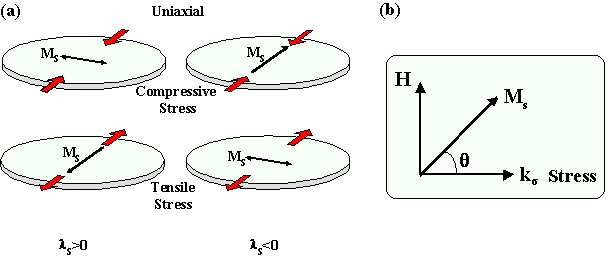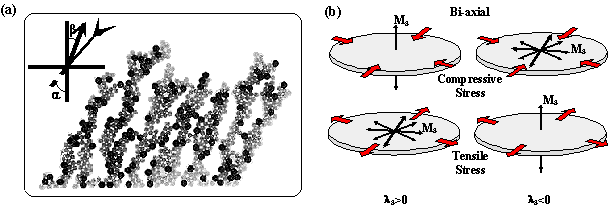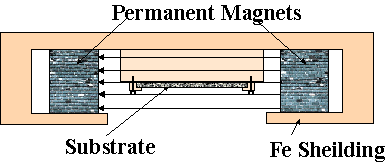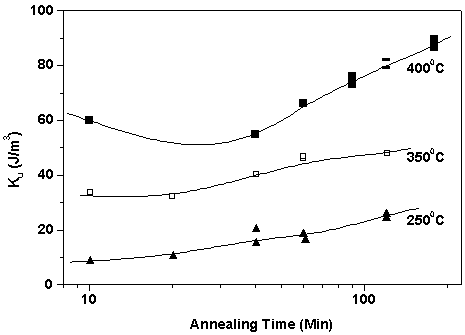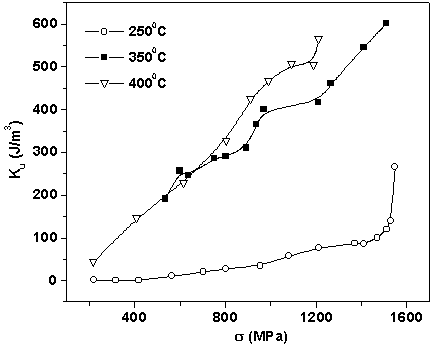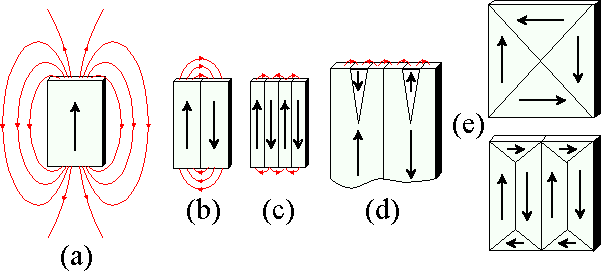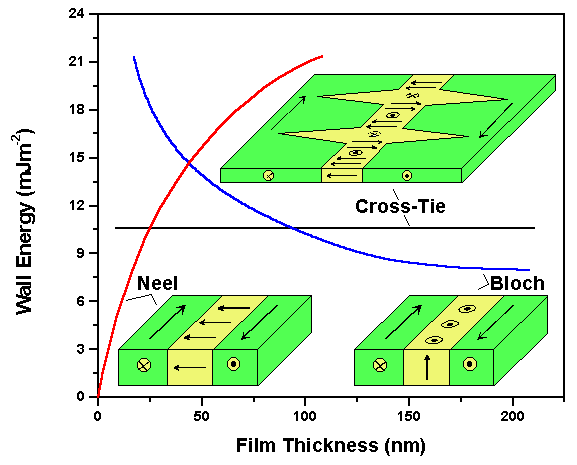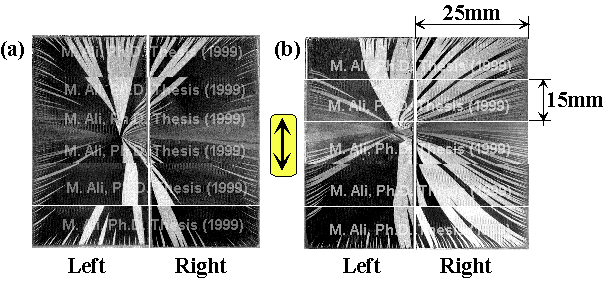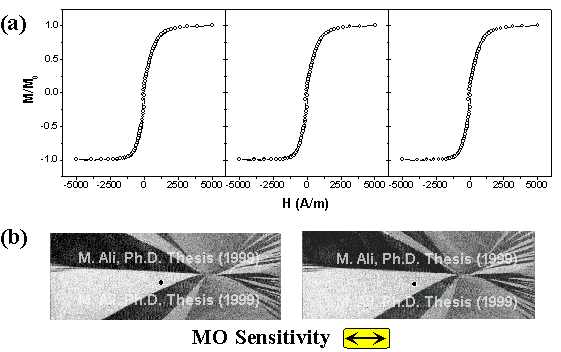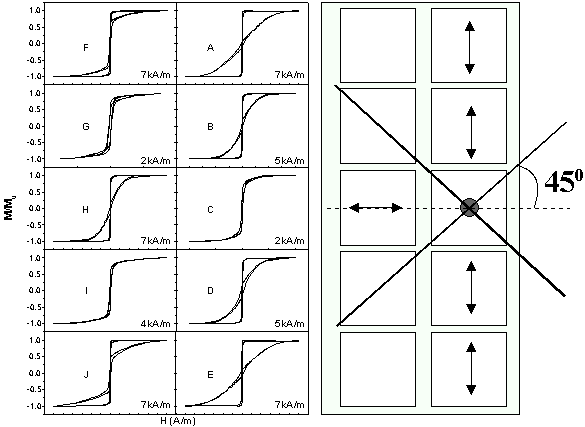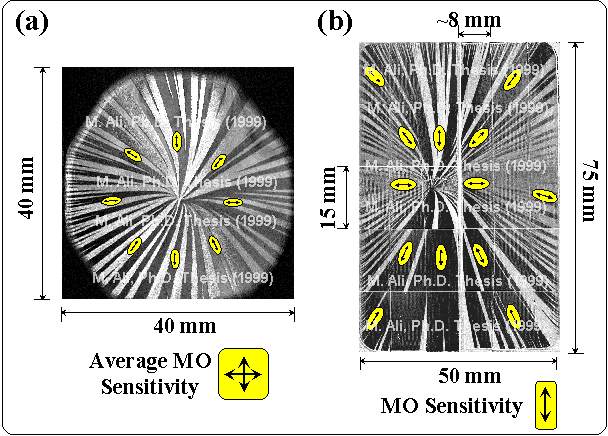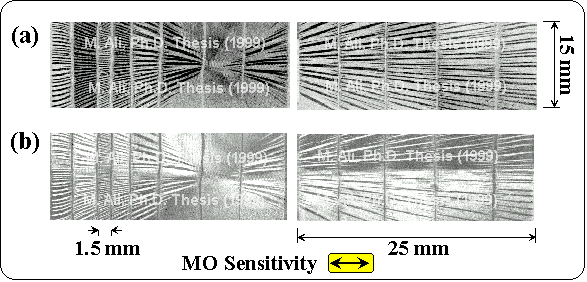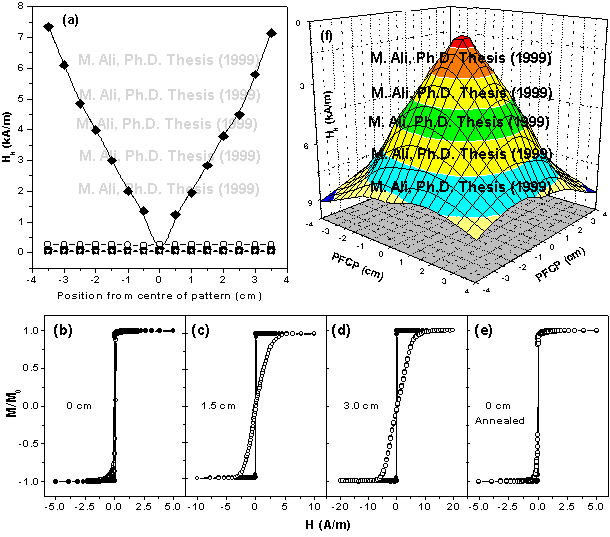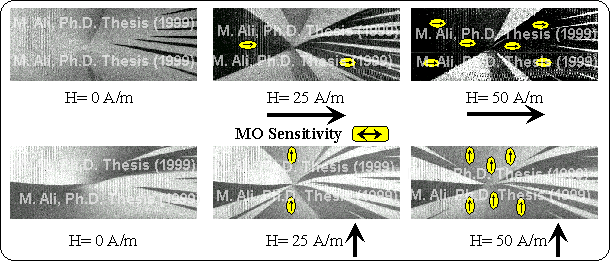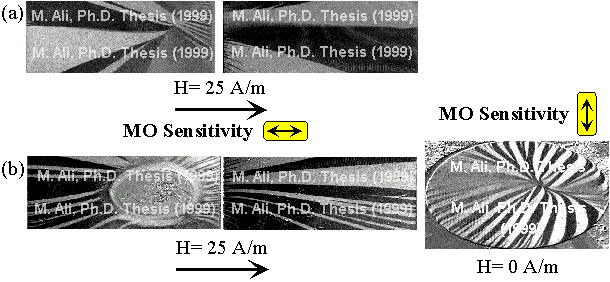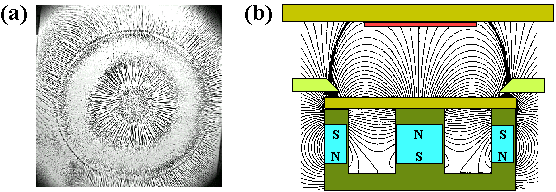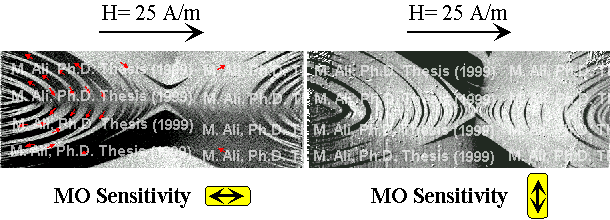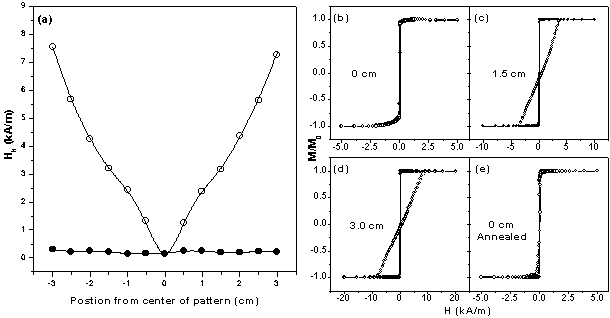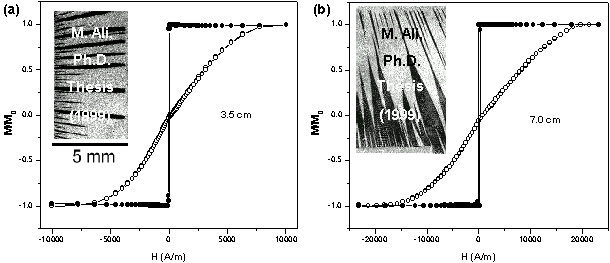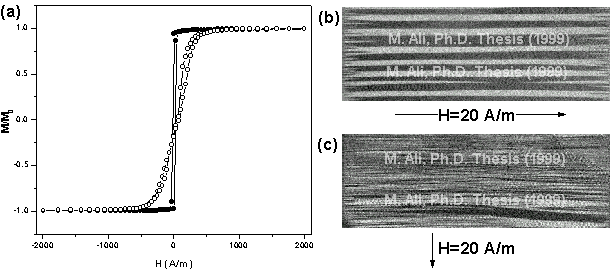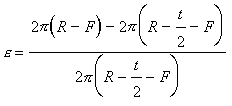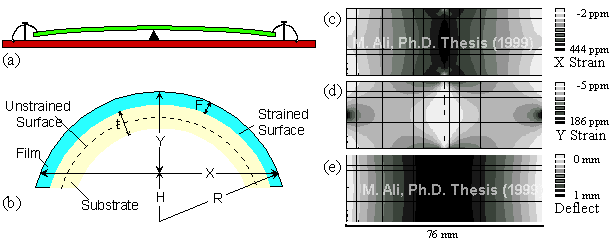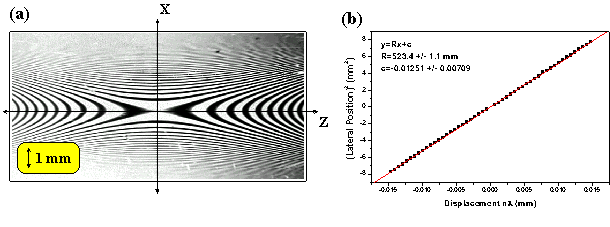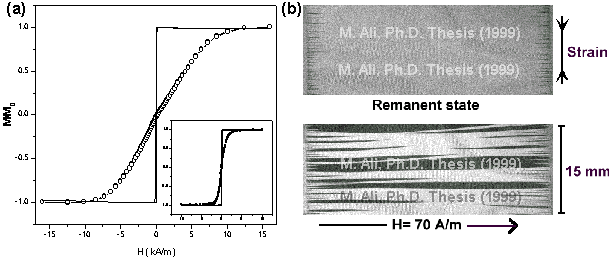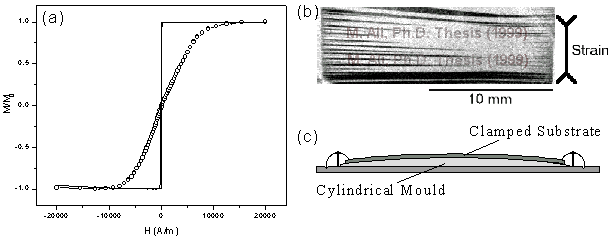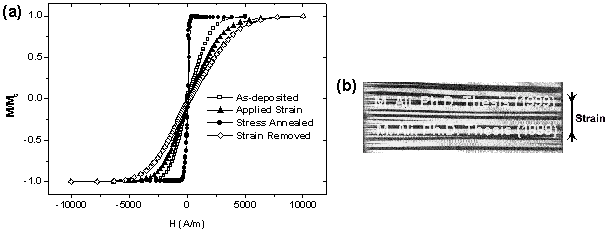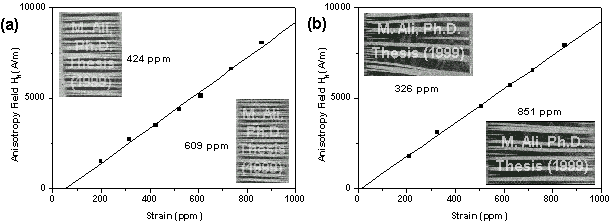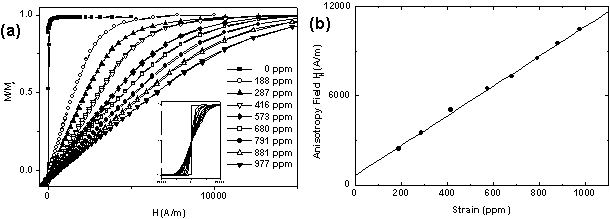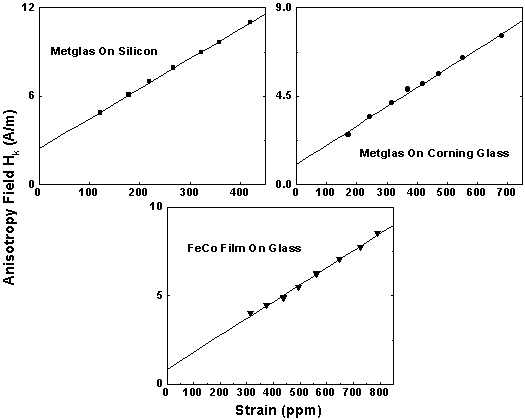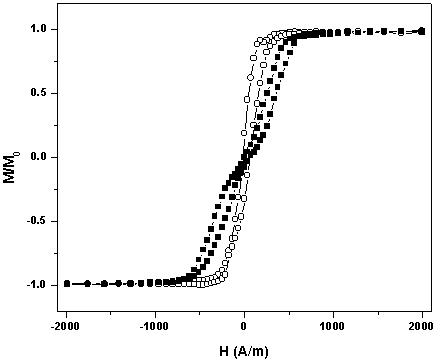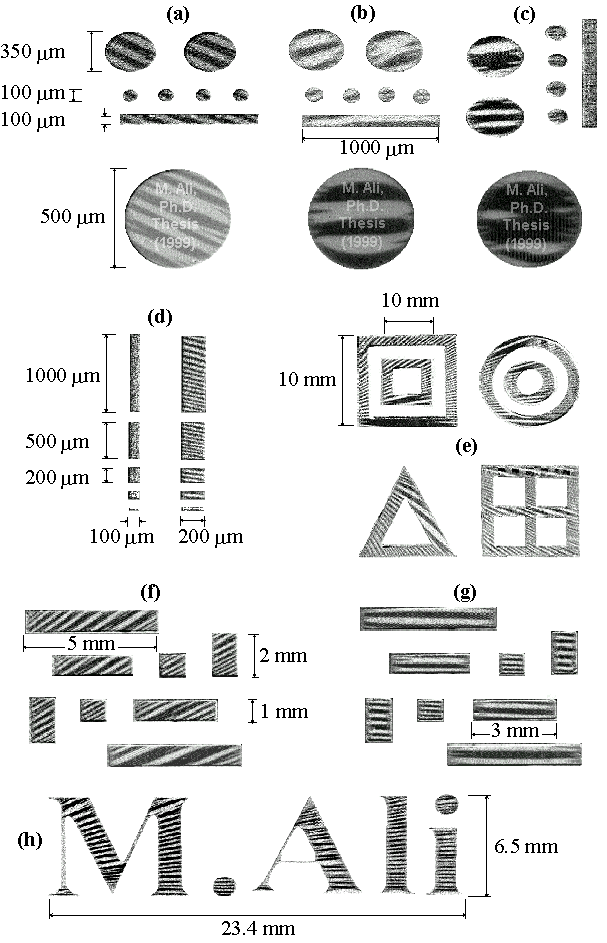| Email:Mannan.Ali@physics.org | Chapter 5: Magnetic Anisotropy In Amorphous Films |
|---|---|
| Web: http://members.xoom.com/MannansZone/thesis.html |
5.0 Magnetic Anisotropy In Amorphous Films
This chapter is concerned with the magnetic anisotropy of amorphous FeSiBC films which have been deposited by RF magnetron sputtering, mainly at the optimised sputtering parameters of 75W and 4mTorr (Chapter 5). The magnetic properties were investigated mainly using the magneto-optical Kerr effect, with both point hysteresis measurements and domain imaging. A significant in-plane anisotropy was observed in the as-deposited films, which has been attributed to the residual field from the magnetron sputtering source. The effects of various treatments on the films are investigated, including the use of forming fields, stress, and thermal processing. The deliberate introduction of stress into these materials is found to allow excellent control of both the direction and magnitude of the magnetic anisotropy. The treatments are evaluated for their potential to control the anisotropy in magnetostrictive device applications.
A simple new technique is also described for the measurement of the saturation magnetostriction in amorphous thin films deposited onto rigid substrates. The method is based on mechanically introducing a small curvature in the substrate either during the deposition (strained growth) or post-deposition. The strain induced anisotropy is measured using the magneto-optical Kerr effect. Quantification of the film strain is obtained using optical interference and stylus measurements; coupled with mechanical finite element modelling, this allowed the saturation magnetostriction to be determined. No information concerning the mechanical properties of the substrate are required and, providing that the Young’s modulus and Poisson’s ratio of the film are known accurately, the values of magnetostriction obtained are both accurate and absolute. It is envisaged that the technique could be applied to a wide variety of films deposited onto commercially important substrates. Here, it is applied to amorphous FeSiBC films deposited onto glass and silicon substrates. A high degree of control is also demonstrated in tailoring the anisotropy field, by the technique of substrate straining.
5.1 IntroductionMost ferromagnetic thin films display a uniaxial anisotropy in plane irrespective of whether they are produced by vapour or sputter deposition techniques. This anisotropy is not always obvious from measurement of bulk hysteresis loops, especially if the film consists of a complex multi-domain structure, where the magnetisation process across the entire film will not proceed by coherent moment rotation, even though each domain structure is uniaxially magnetised. These magnetised domain regions within the film can be seen from domain patterns using, for example, the magneto optical Kerr effect as described in Chapter 2 or point MOKE hysteresis loops if the domains are larger than the sampling area of the laser. The domain images show a tendency for domain walls to lie along preferred directions in the plane of the film. It is well known that the application of a magnetic field during the deposition has the effect of ensuring that the easy axis of magnetisation of the whole film is in the one direction (ie. uniaxial).
| Growth and study of magnetostrictive FeSiBC thin films, for device applications, Mannan Ali (1999) | 79 | |
|---|---|---|
| (Online Copy) |
| Email:Mannan.Ali@physics.org | Chapter 5: Magnetic Anisotropy In Amorphous Films |
|---|---|
| Web: http://members.xoom.com/MannansZone/thesis.html |
The importance of the magnetic anisotropy in magnetostrictive films is becoming increasingly significant, since these magnetically soft, amorphous films are being widely utilised in the production of a new generation of magnetic sensors and actuators [Ref. List (5.1)]. The incorporation of these materials into micro-electromechanical systems requires a good control of the magnetic anisotropy in sensor elements of various aspect ratios and thicknesses. For actuators, the maximum magnetostrictive deflection is obtained when the magnetic moments are rotated coherently through 90°. Such a rotation is conveniently achieved by the application of an external magnetic field along the hard axis of a sample which has a well defined uniaxial anisotropy. It is therefore essential, not only from the point of view of sensor applications, but also from that of understanding the material’s magnetic behaviour, that the magnetic anisotropy of the material is understood, since the magnetic anisotropy strongly affects the magnetisation process and therefore the shape of the hysteresis loop, which is widely used to characterise magnetic materials.
5.2 Magnetocrystalline AnisotropyMagnetic materials tend to display a directional dependence of their properties, and this is a consequence of the magnetic anisotropy. The magnetic anisotropy describes the preference of the magnetisation to lie in a particular direction. The magnetic anisotropy in crystalline materials has clearly been demonstrated where certain crystallographic directions are easy directions of magnetisation, whilst others are hard directions. This has been ascertained by the measurement of magnetisation curves. In the absence of any applied external magnetic field the magnetisation prefers to lie along an easy axis, since this minimises the magnetic energy of the system. The easy and hard directions can be distinguished by the magnetic field needed to achieve magnetic saturation. A prime example is a single crystal of Fe, where the <100> directions are easy axes of magnetisation, whilst the <111> directions are said to be hard axes of magnetisation [Cullity (1972)]. This form of magnetic anisotropy is referred to as the crystal anisotropy, or magnetocrystalline anisotropy, which is intrinsic to the material. The crystal anisotropy originates from the spin-orbit interaction where the electron spin is coupled to the electron orbit. When a magnetic field is applied to rotate the electron spins, it also attempts to reorientate the electron orbit which, however, is strongly coupled to the crystal lattice. The magnetic field or energy needed to rotate the electron spin’s (magnetisation) is known as the crystal anisotropy energy, which is the energy needed to overcome the spin-orbit interaction. The expression for the crystal anisotropy energy density for a cubic crystal can be expressed by equation (5.1) [Cullity (1972)]
| (5.1) |
where K0, K1, K2… are the anisotropy constants, which are material dependent and ai are the directional cosines of the angle between the magnetisation and crystal axes. This intrinsic crystal anisotropy is not preserved in amorphous materials, since the crystal field rapidly averages to "zero" on a macroscopic
| Growth and study of magnetostrictive FeSiBC thin films, for device applications, Mannan Ali (1999) | 80 | |
|---|---|---|
| (Online Copy) |
| Email:Mannan.Ali@physics.org | Chapter 5: Magnetic Anisotropy In Amorphous Films |
|---|---|
| Web: http://members.xoom.com/MannansZone/thesis.html |
scale because of the amorphous arrangement of the atoms. On a local scale, it can be assumed that there is some "crystalline" anisotropy because of nearest neighbour interactions, which will be very of a short range, and therefore the average macroscopic crystal anisotropy is close to, or equal to, zero. It should be remembered that ferromagnetism is a result of the exchange energy which is mainly dominated by the interaction between adjacent electron spins and their separations. Instead a number of other (see below) magnetic anisotropies can exist, which are usually induced in some manner, giving rise to a magnetic anisotropy which is uniaxial in direction. This means that there is a single, preferred direction, which for films is usually in the plane of the film. The tendency for the magnetisation to lie along such an easy axis, can be expressed as an anisotropy energy density, EK, in a series of powers of sinq. The expression for the energy density for a uniaxial anisotropy is:
| (5.2) |
where q is the angle between the easy axis, and the direction of the magnetisation MS, and Ku0, Ku1, Ku2,… are the uniaxial anisotropy constants. The first anisotropy constant, Ku0, which is independent of q is usually neglected since it gives no change in EK when the direction of the magnetisation changes; Ku2 and higher order terms can also be neglected because they are relatively small in comparison to Ku1. This gives the following approximate expression for the uniaxial magnetic anisotropy as
| (5.3) |
where Ku is the uniaxial anisotropy constant. It can be seen from these expressions that the anisotropy energy is a minimum when the magnetisation lies along an easy axis (q=00, 1800), and is a maximum when magnetisation is perpendicular to the easy axis (q=900, 2700). The magnitude of the induced anisotropy is usually monitored by measuring the anisotropy constant Ku or the anisotropy field HK, which is related to the anisotropy constant:
 | (5.4) |
where Ms is the saturation magnetisation and m0 is the permeability of free space. In this thesis the author has mainly used the anisotropy field when making comparisons of the magnitude of the uniaxial anisotropy present in the FeSiBC films, since the values were obtained from the measured hysteresis loops.
| Growth and study of magnetostrictive FeSiBC thin films, for device applications, Mannan Ali (1999) | 81 | |
|---|---|---|
| (Online Copy) |
| Email:Mannan.Ali@physics.org | Chapter 5: Magnetic Anisotropy In Amorphous Films |
|---|---|
| Web: http://members.xoom.com/MannansZone/thesis.html |
5.3 Shape Anisotropy
The shape anisotropy results from the demagnetising fields which occur within a magnetised material. The shape of the sample has the effect of creating directions in which it is easier to magnetise the sample, and this is governed by the demagnetising field, Hd, which, in the material, points in the opposite direction to the magnetisation and the applied field. For instance, a smaller field is required to magnetise a long cylindrical magnetic rod along its length, because of the smaller demagnetising field, compared to the magnetic field required to magnetise the rod along a diameter. If one thinks in terms of magnetic poles, the strength of the demagnetising field depends upon the separation between these opposite magnetic poles. The poles generated at the ends of a rod are much further apart, giving rise to a small demagnetising field, whereas the magnetic poles will be much closer together when the rod is magnetised across its diameter, thus producing a larger demagnetising field. The demagnetising field depends solely on the magnetisation and the demagnetising factor, and is expressed as
| (5.5) |
where Nd (0£Nd£1) is the demagnetising factor which is shape dependent, and M is the magnetisation. The Nd term is calculated solely from the geometry of the sample and can only be calculated exactly for an ellipsoid. The energy associated with this demagnetising field can be expressed as follows, and is referred to as the magnetostatic energy density.
 | (5.6) |
The shape anisotropy has an obvious importance in thin films, since there is a significant shape anisotropy because of the thickness of the film. It is well known that the magnetisation usually lies in-plane for a film in the absence of any crystal anisotropy or any other anisotropy which would cause the magnetisation to lie out of plane. In general, a thin film can be approximated by a flat ellipsoid or an oblate spheroid; this allows one to determine approximately the demagnetising factors for a thin film system. The demagnetising factor for an oblate spheroid [Craik (1995)] with the magnetisation in the plane of the film is given by
 | (5.7) |
 | (5.8) |
| Growth and study of magnetostrictive FeSiBC thin films, for device applications, Mannan Ali (1999) | 82 | |
|---|---|---|
| (Online Copy) |
| Email:Mannan.Ali@physics.org | Chapter 5: Magnetic Anisotropy In Amorphous Films |
|---|---|
| Web: http://members.xoom.com/MannansZone/thesis.html |

Figure 5.1: (a) Illustration of an oblate spheroid, to approximate a thin film. In general thin films tend be square, or circular. A photograph of a 500nm thick circular FeSiBC film 1cm diameter is also shown, which was deposited onto square glass substrate through a circular mask. (b) Domain image from a circular demagnetised FeSiBC film.
where q is the ratio of the of the diameter (d) of the spheroid to its thickness (t) as shown in Figure 5.1. This is a reasonable approximation for the films which were typically investigated in this thesis; the films were generally either rectangular (mainly square), or circular as shown in Figure 5.1. Using equation (5.6), and the typical values of d=1cm, t=500nm the demagnetising factor, Nd, in the plane of the film is of the order of 3.9´10-5. Essentially, the in-plane demagnetising factor is equal to zero and the demagnetising factor perpendicular to the plane of the film is therefore equal to one (Nx+Ny+Nz=1). Hence the easy-axis is in the plane of the film, whilst the hard axis is perpendicular to the plane of the film. This means that any competing anisotropy, or an applied field, must overcome the demagnetising field which is equal to the magnetisation M (Eq. 5.5), in order to rotate the magnetisation out of the plane of the film. It is therefore important to be aware of the shape anisotropy in the design process of thin film sensors in situations where the x-y dimensions of the film approach the thickness of the film, since the in-plane demagnetising field will no longer be negligible. The magnetic field, Hint, the sensor will experience in this situation will be
| (5.9) |
where Happl is the external applied magnetic field. The shape anisotropy can cause the sensor to perform differently compared with measurements made on much larger devices.
Another anisotropy which is related to the shape of the film, is the surface anisotropy. In very thin films (<5nm) the surface or the film/substrate interface can give rise to a significant surface anisotropy [Gradmann (1986), Mattheis et al (1999)]; this can strongly influence the magnetic properties when the surface to volume ratio is comparable with or larger than that of the film thickness. The surface anisotropy is due to the abrupt change in the structural and chemical environment at the surface and can cause the magnetisation to point out of the plane of the film. Most thin film sensors tend be 100nm or thicker to ensure a good signal to noise ratio.
However, the absence of any shape anisotropy in the plane of the film (d>>t) and/or any significant magnetocrystalline anisotropy in the amorphous films, does not imply that all directions for the magnetisation within the plane of the film are energetically equal, as is shown in Figure 5.1b. In this instance, a circular FeSiBC film deposited in this study was repeatedly demagnetised; it was found from
| Growth and study of magnetostrictive FeSiBC thin films, for device applications, Mannan Ali (1999) | 83 | |
|---|---|---|
| (Online Copy) |
| Email:Mannan.Ali@physics.org | Chapter 5: Magnetic Anisotropy In Amorphous Films |
|---|---|
| Web: http://members.xoom.com/MannansZone/thesis.html |
domain imaging and hysteresis measurements that an approximately uniaxial anisotropy existed across the film, which was always orientated along the same direction. This anisotropy cannot be due to the shape anisotropy, since all directions should be equally magnetisable; therefore it is a result of some other anisotropy (see later).
5.4 Magnetostriction and MagnetoelasticityWhen the state of magnetisation of a magnetic material is altered by an external magnetic field, it also experiences a change in its physical dimensions, provided that part or all of the magnetisation process occurs by magnetisation rotation as opposed to domain wall displacement. This change in dimension gives rise to a strain which is referred to as the magnetostriction as denoted by l (Eq. 5.10)
 | (5.10) |
where l is the length of the sample before the applied field and Dl is the change in length due to the applied field. The magnetostriction is due to the spin-orbit coupling which is also responsible for the magnetocrystalline anisotropy and they are both intrinsically related [Cullity (1972)]. This type of magnetostriction is known as longitudinal or linear magnetostriction. There are two main sources of magnetostriction, spontaneous magnetostriction which results from the ordering of the magnetic moments at the Curie temperature thus giving rise to a lattice strain, and the field induced magnetostriction, which is a consequence of the domain magnetisation being altered by an external magnetic field and which is due to the rotation of this lattice strain. The magnetostrictive strain l increases as a function of applied field up to the point of magnetic saturation and is known as the saturation magnetostriction, ls. It is defined as the fractional change in length between the demagnetised state and the magnetically saturated state. The magnetostrictive strain can have values which are either positive, negative, or in some cases, nearly zero depending upon the composition of the material; this means that, on application of a magnetic field, a positively magnetostrictive material will elongate in the direction of the applied field, whereas it will contract if it is negatively magnetostrictive. It is found that ls is anisotropic for crystalline materials and is therefore defined relative to the crystal axis along which the magnetisation lies. For amorphous materials the magnetostriction is isotropic and a simple expression relates the magnetostrictive strain to the magnetisation as shown in equation (5.11)
 | (5.11) |
| Growth and study of magnetostrictive FeSiBC thin films, for device applications, Mannan Ali (1999) | 84 | |
|---|---|---|
| (Online Copy) |
